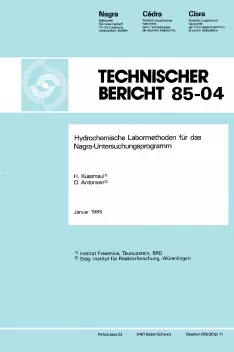
Technischer Bericht NTB 85-04
Hydrochemische Labormethoden für das Nagra-Untersuchungsprogramm
Nagra's geological research program is directed toward determination of the possibilities for depositing high level radioactive waste at depth in Northern Switzerland. The program includes ground water analyses for chemical and biological constituents (analyses by Institut Fresenius) as well as for dissolved gases, uranium, and natural radioactivity (analyses by EIR, Eidgenössisches Institut für Reaktorforschung).
Two sources were utilized to obtain formation water chemistry in the study area. A regional program was established to investigate mineral and thermal waters. 17 sites of the regional program are scheduled for long term monitoring of water chemistry. A deep drilling program (12 locations projected) was initiated to obtain and analyze water samples from defined depths and formations under in situ conditions.
Chapter 2 presents the analytical programs in detail. General chemistry was determined in all samples. Minor inorganic and organic constituents, however, were analysed according to the relevance and quality of the respective samples.
In the regional program, well equipped wells and springs provided representative samples at most locations (cf chapter 3). However, at other locations impairment of sample quality could not be avoided.
Given sufficient water flow, samples for the deep drilling program were taken both at the earth's surface under atmospheric pressure conditions (from artesian outflow or after pumping), and under formation pressure at various depths with specialized sample containers (chapter 3.7.3).
Chapter 4 gives a listing of all analytical methods used in the study, their accuracy ranges and detection limits.
Finally, this paper also presents some special problems encountered during the deep drilling program (cf chapter 5). Influx of drilling fluid, for instance, introduces non-formation substances into the samples. Also, gases which are dissolved in the water under formation pressure are liberated during sampling under reduced pressure conditions, inducing changes in the carbon-dioxide-carbonate and, accordingly, the pH-system.
Preliminary results show that no single method can provide completely satisfactory results for all deep drilling water sampling. A combination of procedures and critical evaluation of their respective data can, however, provide valuable information on the chemistry of waters from certain formations.
